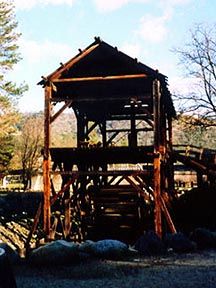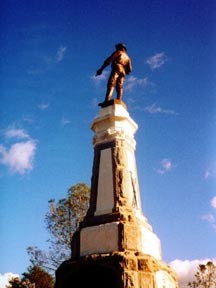|
Gold Discovery
On January 24, 1848, James W. Marshall discovered gold at a sawmill in Coloma that he was constructing for John Sutter, a wealthy land developer from the Sacramento Valley.

Sutter's Mill in Coloma
|
The Fort & The Mill ~ Sutter's empire was headquartered at Sutter's Fort near the confluence of the Sacramento and American rivers in the Sacramento Valley, but his ambition prompted him to enter into a partnership with a carpenter named James Marshall to build a mill in the foothills so that timber might be floated down the American River to his river-front property in the valley and be used to expand his domain. Marshall would supply the expertise and Sutter would pick up the tab.
During the mill's construction, the workers diverted the river each night through the manmade ditch, or tailrace, under the mill to help deepen it. When construction resumed in the morning, the flow would be stopped for the day.
It's Gold! ~ One winter day, while inspecting the previous night's progress on the tailrace, Marshall noticed some metal glittering in the drained area. Believing that he may have found gold, he tested it, one time by dropping some of it into a big iron kettle where Mrs. Wimmer was boiling soap. This treatment had no effect on the yellow metal, which convinced him it must be gold. Within a few days, he headed for Sutter's Fort, where he and John Sutter subjected the metal to several other tests. The conclusion was clear - It was gold!
Did Sutter Prosper? ~ Sutter attempted to keep the discovery a secret and ordered his men not to breathe a word of it until he could obtain official title to the mineral rights in Coloma. This land belonged to the Culluma Indians and had not been included in the 48,000-acre grant he received from Mexican Governor Alvarado a decade earlier. But who was going to complain if he used it for his mill? After all, the entire California territory was in the process of being ceded to the United States, so ownership was, well, unsettled at best.
Unfortunately for Sutter, he was not able to keep the hoards of miners off the land around the mill, nor did he become its lawful owner, and the discovery of gold turned out to be his ruin. His valley settlement was all but deserted with the onslaught of the Gold Rush, except for squatters on his land. There was no one left to tend the Fort's businesses, livestock, or crops. The last years of Sutter's life were spent at the nation's capitol trying in vain to convince Congress to compensate him for his losses brought on by the California Gold Rush. He died a poor man in Pennsylvania.
So Marshall Got Rich? ~ Neither was Marshall benefited by his gold discovery. Although he tried to charge men to mine at Coloma, he succeeded with only a very few gullible miners and never gained wealth from his discovery. He and his partner John Winters spent thousands of dollars constructing a tunnel to divert the river from its natural course, hoping to expose the gold-rich riverbed. Their attempts were unsuccessful. They operated the mill until 1852.
Marshall, unwisely claiming to have special powers for locating rich gold deposits, was followed wherever he tried to stake a claim and was sometimes threatened. He lived in a small cabin in Coloma, caring for his vines and fruit trees while supporting himself doing handyman jobs such as carpentry. He also made two lecture tours that were somewhat successful because many people wanted to see the man who had such a vital role in initiating the Gold Rush.

Marshall's Monument in Coloma
|
In recognition of his contribution to the State by his discovery, the 1872 Legislature appropriated a small monthly pension for him. It was reduced a few years later and stopped altogether six years after it started, perhaps because of rumors that the money was being liquidated (liquordated?) at the local saloon. He ended up blacksmithing in Kelsey, a few miles from Coloma, supplementing his income by selling his autograph on bits of paper.
Marshall died a bitter and misunderstood man on August 10, 1885. He is buried near his Coloma cabin in the State Historic Park that bears his name, beneath the monument erected in his honor five years after his death. The monument has a bronze statue of Marshall on top, looking towards the mill, with one hand pointing to the gold discovery site.
Coloma is Born ~ After Marshall's gold discovery, a booming little town soon developed, and the Indian name "Culluma" was changed to Coloma. It was the first place fortune-seekers headed for when they arrived in San Francisco, until gold was discovered in surrounding areas.
As gold dwindled in Coloma, it became a trade center for the new camps. Ironically, the Gold Rush merchants often did better financially than the miners themselves because they sold goods and supplies at outrageously inflated prices, an extreme example of capitalizing on supply and demand.

GOLD RUSH COUNTIES:
MARIPOSA | TUOLUMNE | CALAVERAS | AMADOR | EL DORADO | PLACER | NEVADA | SIERRA


Copyright ©1998-2019 ComSpark. All rights reserved. Keeper of the Book
|